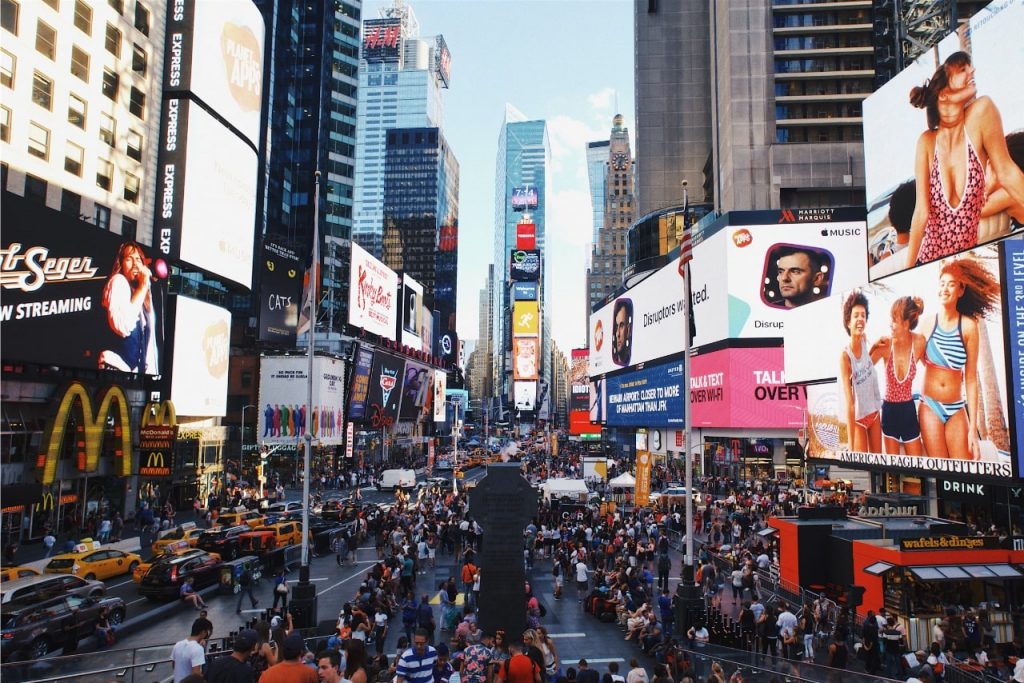Signage is one of the earliest forms of marketing. Examples abound from as far back as Ancient Rome and beyond. But even those who aren’t history buffs will still recognize the old-fashioned wooden signs of medieval English pubs. So, what does this have to do with digital signage? Signage has come a long way from its humble beginnings. It continues to evolve with the introduction of digital technologies. We take a look at what this means for the modern-day marketing approach.
What is Digital Signage?
Before I launch into my pitch for why digital signage is the best thing since the advent of Keurig machines (did you think I was going to compare this amazing technology to boring old sliced bread?), let me briefly explain what it is. Digital signage is any type of electronic display that is “centrally managed and individually addressable.” It displays text, animations, and video messages for information, entertainment, advertising, and merchandising to targeted audiences. The most common technologies used in these signs are LCD, LED, and projection. While this may sound complex, most likely, you see examples of digital signage all the time without realizing what it is.
Times Square in New York City is one of the most iconic examples of digital signage. Look at how many people are exposed to those marketing messages all the time! Impressive, isn’t it?
Take the Leap into Digital Signage
Now that we’re completely clear about what digital signage is, let’s dig into why it justifies all the hype.
It’s Eye-Catching
Just look at the picture of Times Square, above. It’s impossible for your eyes not to be drawn to those signs. Whether it is through the use of special fonts, animations, or even full-on videos, digital signage demands people’s attention. This works because human beings are predominantly visual creatures. We get the vast majority of information about our surroundings through our eyes. But does seeing a sign for a product translate into sales? Yes, it does. According to a 2012 study commissioned by FedEx Office, “almost eight in 10 (76 percent) American consumers enter a store they have never visited before based on its signs, and nearly 7 in 10 (68 percent) have actually purchased a product or service because a sign caught their eye.” Even more revealing is the quality of your signage, and that matters. The same study described how 68% of consumers associate the quality of a product or service with the quality of the corresponding signage. In fact, over half of them admitted that poorly-designed or misspelled signs deter them from considering a particular establishment. So, the more eye-catching your signage is, the more likely you are to attract customers. Just don’t forget to use spell check! Traditional signage is everywhere these days. From low-budget election placards stuck into your front lawn to those gigantic billboards along the highway. It’s all designed to get people’s attention and influence their decisions.
The Way Forward
Such advertising has become static and outdated. Digital signage is the way of the future with its dynamic, eye-catching look. New forms of advertising utilize the most advanced technology on the market to wow potential customers. Given what we now know about how the quality of signage affects people’s perceptions of a business, doesn’t it make sense that a flashy digital sign will impress customers more than a stale old billboard? It can be Interactive thanks to touchscreens and motion sensor cameras. Once a customer is interacting with your advertising, you have their attention. From this point, they are very open to persuasion. Experiments have shown this effect is real, and psychologists refer to it as “anchoring.” Anchoring increases recognition and memory retention, making our signs even more effective. In other words, a customer who has interacted with your digital advertising is much more likely to remember the product and consider it favorably in relation to a competitor’s offerings. In fact, industry information clearinghouse Digital Signage Connection claims that the recall rate of digital signage is 83%. Of course, interactivity doesn’t make sense for all types of digital signage or all locations. People might not like having their personal selections displayed for the entire world to see. On the other hand, the “Tell us how we are doing” digital keypads are a perfect example of digital signage that is just begging for a customer’s engagement. Customizable digital menu ordering at restaurants is another great example. Perhaps one of the strongest selling points of digital signage is that it is personalizable. What does this mean? This relates to the ability of a company to tweak its advertising based on each location of a digital sign. There are several options. Here are a few examples:
A public health campaign displays different statistics for different subpopulations based on the composition of different neighborhoods. A store is tailoring its signs to announce a sale in certain stores in a city and not in others. A government office offers the option to read the information in different languages based on customer selection. A multinational company providing weather updates at its various offices based on up-to-the-minute local conditions. Kindle is sending hyper-personalized ads to customers’ devices based on their purchase history. A restaurant modifies its menu based on seasonal changes or customer suggestions.
All of this is managed through a central system, usually based in the cloud and operated from head office. This gives authorized personnel the means to update content and easily access all their signs located near or far.
The Market is Growing
According to Orbis Research, the market for global digital signage is expected to grow by 8% between now and 2024. During this growth, North America will be the largest market.
This means that your competitors are already, or will soon be, on the digital signage bandwagon. In other words, you should think about incorporating digital signage into your business plan to stay competitive. You can jump ahead of your competition in the best-case scenario by modernizing your advertising before they do. It sounds like a win-win situation for us.
Conclusion
Hopefully, by this point, we have convinced you of the wonderous utility of digital signage. Aside from simply being a cool new toy for businesses to experiment with, this technology creates measurable results. It offers something that no previous form of advertising has ever been able to accomplish: the chance to speak to each customer individually. This is a revolutionary idea, but there are further benefits to incorporating digital signage into your advertising plan:
It is cheap. According to our friends at Digital Signage Connection, advertisement on digital displays is 80% less expensive than television ads. Plus, you can’t mute or skip these ads! It doesn’t require expensive maintenance. These signs are built to withstand harsh weather conditions and don’t require regular repair and replacement like traditional banners or billboards. It is eco-friendly. Digital signage uses less electricity than other types of electrical advertising and wastes no paper and fewer resources over its lifetime.
The bottom line is that you need digital signage representing your business if you interact with customers or clients in any way. So, take the leap! You won’t be sorry. You’ll likely be richer for it!

